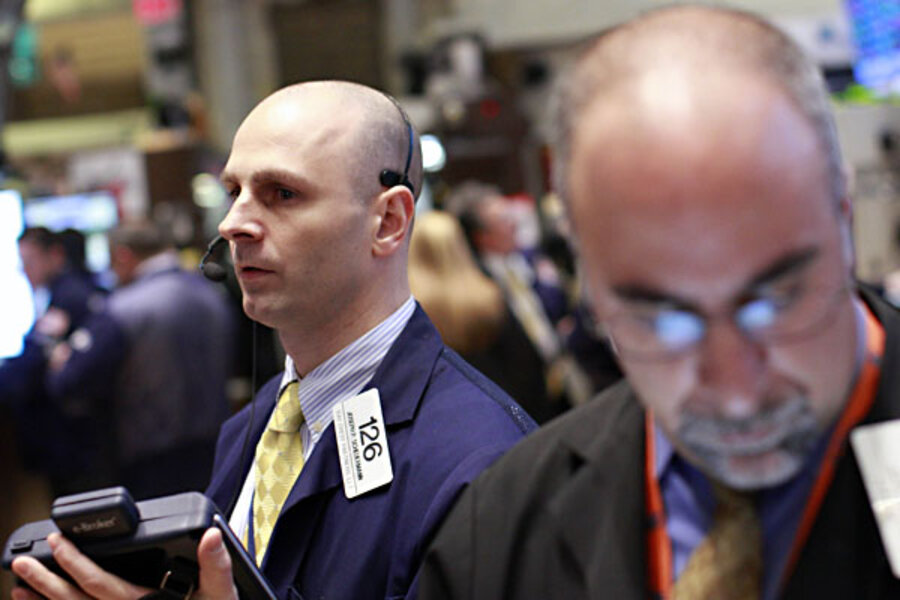Sagging consumer confidence lowers stocks
Loading...
| New York
Major stock indexes dipped Tuesday as weak readings on consumer confidence gave investors little reason to extend the recent rally.
The Dow Jones industrial average dropped 43.90 points to close at 13,197.73, a loss of 0.3 percent. Bank of America fell 3.3 percent, the biggest drop in the Dow, after an analyst downgraded the stock.
Major indexes opened higher, then pulled back after 10 a.m., when the Conference Board said its index of consumer confidence slipped in March. Higher gas prices offset the surging stock market. Around the same time, the Federal Reserve Bank of Richmond, Virginia reported that a measure of regional manufacturing plunged this month.
Other indexes edged lower. The Standard & Poor's 500 index dropped 3.99 points to 1,412.52. The Nasdaq composite fell 2.22 points to 3,120.35.
More than four stocks fell for every three that rose on the New York Stock Exchange. Trading volume was well below average at 3.4 billion.
The S&P 500 index and the Nasdaq are up more than 1 percent for the week. The S&P 500 has already gained 12.3 percent to start the year. That three-month surge easily beats the 8 percent return most fund managers hope to make in a whole year. The Nasdaq is up even more for the year, 19.8 percent.
Brian Gendreau, market strategist at Cetera Financial, said the stock market still has room to go higher even after such a strong start. Companies in the S&P 500 index are trading for around 13 times their expected earnings over the next year, below the average of 14.6 times over the past decade. And there's plenty of cash still tucked away in the Treasury market.
"Compared to bonds, stocks remain very attractive," Gendreau said. "That doesn't tell you if we'll get a move in a week or a month from now, but it does tell you that there's a lot of pent-up demand."
Earnings from Lennar Corp. pulled housing stocks up. The country's third-largest builder reported quarterly profits that beat analysts' estimates by delivering more houses and pulling in more orders. Lennar rose 4.7 percent, the best gain in the S&P 500 index. PulteGroup rose 3.6 percent, D.R. Horton 2.8 percent.
The economic reports on consumer confidence and regional manufacturing helped push up prices in the U.S. government debt market, where traders park funds when the economy looks sluggish. The 10-year Treasury note rose 53 cents for every $100 invested. The yield fell to 2.18 percent from 2.26 percent late Monday.
Demand for Treasurys has pulled yields down from highs reached last week. The yield on the 10-year note touched 2.4 percent last Tuesday, the highest yield since October.
Natural gas prices fell again Tuesday on rising supplies and warmer winter weather. Natural gas futures fell 1.8 cents to $2.21 per 1,000 cubic feet. That's near a 10-year low and half of what natural gas fetched back in July.
Any money that consumers are saving on natural gas could wind up in the gasoline tank. The national average for regular gasoline in the U.S. is $3.90 per gallon. It's risen 62 cents since Jan. 1.
Among stocks making big moves:
— Walgreen Co. rose 1.2 percent. The drugstore chain posted a drop in quarterly earnings but the results still topped analysts' expectations.
— Apollo Group Inc. fell 8.5 percent, the biggest drop in the S&P 500. The for-profit education company reported a profit in the most recent quarter but issued a dim forecast. Apollo expects fewer students to enroll in the coming quarter.
— Ista Pharmaceuticals Inc. leapt 7.8 percent on news that Bausch & Lomb plans to buy the drug maker for roughly $500 million in cash. Ista gets most of its revenue from Bromday, an eye drop for patients recovering from cataract surgery. Bausch & Lomb plans to pay $9.10 per share for Ista, a 72-cent premium over Monday's closing price. Bausch & Lomb is privately held.





